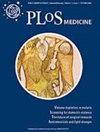美国老年医疗保险受益人处方阿片类药物剂量轨迹和阿片类药相关不良事件风险:一项嵌套病例对照研究
IF 9.9
1区 医学
Q1 MEDICINE, GENERAL & INTERNAL
引用次数: 6
摘要
背景尽管越来越多的老年人因阿片类药物滥用、依赖和中毒而就医,但对处方阿片类药物剂量模式及其与老年患者阿片类药物相关不良事件(orae)风险的关系知之甚少。该研究旨在比较老年慢性非癌性疼痛(CNCP)患者在发生ORAE前6个月处方阿片类药物剂量的轨迹。方法和研究结果我们在2011年至2018年5%的全国随机医疗保险受益人中,对诊断为CNCP的老年(≥65岁)患者进行了巢式病例对照研究,这些患者是处方阿片类药物的新使用者。从平均随访2.3年的队列中,我们确定了3103例在事件发生前6个月内处方≥1种阿片类药物的ORAE病例,以及3103例性别、年龄和开始服用阿片类药物时间相匹配的对照组。关键暴露是处方阿片类吗啡毫克当量(MME)每日剂量在ORAE事件或匹配对照发生前6个月的轨迹。在病例和对照组中,女性2192例(70.6%),平均(SD)年龄为77.1岁。在ORAE事件诊断或匹配日期之前,出现了四种处方阿片类药物轨迹:逐渐停药(每日MME≤3至0,1,456例[23.5%]),逐渐增加剂量(每日MME从0至bb0.3, 1,878例[30.3%]),持续低剂量(每日MME 3至5例,1,510例[24.3%]),以及持续中等剂量(每日MME 3至20例,1,362例[22.0%])。少数老年患者(<5%)在诊断前6个月或匹配日期的平均日剂量≥90每日MME。逐渐停药的患者与持续低剂量、中剂量和增加剂量的患者相比,更可能是年龄较小(65至74岁)的美国中西部居民,并且没有接受低收入补贴。与逐渐停药的患者相比,逐渐增加剂量的患者(校正优势比[aOR] = 3.4;95%置信区间(CI) 2.8 ~ 4.0;P < 0.001),一致的低剂量(aOR = 3.8;95% CI 3.2 ~ 4.6;P < 0.001),一致的中等剂量(aOR = 8.5;95% CI 6.8 ~ 10.7;校正协变量后,P < 0.001)发生ORAE的风险较高。我们的主要发现在使用治疗加权逆概率分析的队列研究的敏感性分析中仍然稳健。主要限制包括研究结果的有限普遍性和缺乏关于非法阿片类药物使用的信息,这阻碍了对增加老年人ORAE风险的临床剂量阈值水平的了解。结论:在老年医保受益人样本中,确定了4种处方阿片类药物剂量轨迹,大多数处方剂量在ORAE或匹配日期前6个月内低于90每日MME。与停用阿片类药物的患者相比,逐渐增加阿片类药物剂量的老年患者或持续使用低至中等剂量阿片类药物的患者发生ORAE的风险增加。老年患者是否易受低剂量阿片类药物影响还有待进一步调查。本文章由计算机程序翻译,如有差异,请以英文原文为准。
Trajectories of prescription opioid dose and risk of opioid-related adverse events among older Medicare beneficiaries in the United States: A nested case–control study
Background Despite the rising number of older adults with medical encounters for opioid misuse, dependence, and poisoning, little is known about patterns of prescription opioid dose and their association with risk for opioid-related adverse events (ORAEs) in older patients. The study aims to compare trajectories of prescribed opioid doses in 6 months preceding an incident ORAE for cases and a matched control group of older patients with chronic noncancer pain (CNCP). Methods and findings We conducted a nested case–control study within a cohort of older (≥65 years) patients diagnosed with CNCP who were new users of prescription opioids, assembled using a 5% national random sample of Medicare beneficiaries from 2011 to 2018. From the cohort with a mean follow-up of 2.3 years, we identified 3,103 incident ORAE cases with ≥1 opioid prescription in 6 months preceding the event, and 3,103 controls matched on sex, age, and time since opioid initiation. Key exposure was trajectories of prescribed opioid morphine milligram equivalent (MME) daily dosage over 6 months before the incident ORAE or matched controls. Among the cases and controls, 2,192 (70.6%) were women, and the mean (SD) age was 77.1 (7.1) years. Four prescribed opioid trajectories before the incident ORAE diagnosis or matched date emerged: gradual dose discontinuation (from ≤3 to 0 daily MME, 1,456 [23.5%]), gradual dose increase (from 0 to >3 daily MME, 1,878 [30.3%]), consistent low dose (between 3 and 5 daily MME, 1,510 [24.3%]), and consistent moderate dose (>20 daily MME, 1,362 [22.0%]). Few older patients (<5%) were prescribed a mean daily dose of ≥90 daily MME during 6 months before diagnosis or matched date. Patients with gradual dose discontinuation versus those with a consistent low dose, moderate dose, and increase dose were more likely to be younger (65 to 74 years), Midwest US residents, and receiving no low-income subsidy. Compared to patients with gradual dose discontinuation, those with gradual dose increase (adjusted odds ratio [aOR] = 3.4; 95% confidence interval (CI) 2.8 to 4.0; P < 0.001), consistent low dose (aOR = 3.8; 95% CI 3.2 to 4.6; P < 0.001), and consistent moderate dose (aOR = 8.5; 95% CI 6.8 to 10.7; P < 0.001) had a higher risk of ORAE, after adjustment for covariates. Our main findings remained robust in the sensitivity analysis using a cohort study with inverse probability of treatment weighting analyses. Major limitations include the limited generalizability of the study findings and lack of information on illicit opioid use, which prevents understanding the clinical dose threshold level that increases the risk of ORAE in older adults. Conclusions In this sample of older patients who are Medicare beneficiaries, 4 prescription opioid dose trajectories were identified, with most prescribed doses below 90 daily MME within 6 months before ORAE or matched date. An increased risk for ORAE was observed among older patients with a gradual increase in dose or among those with a consistent low-to-moderate dose of prescribed opioids when compared to patients with opioid dose discontinuation. Whether older patients are susceptible to low opioid doses warrants further investigations.
求助全文
通过发布文献求助,成功后即可免费获取论文全文。
去求助
来源期刊

PLoS Medicine
医学-医学:内科
CiteScore
21.60
自引率
0.60%
发文量
227
审稿时长
3 months
期刊介绍:
PLOS Medicine aims to be a leading platform for research and analysis on the global health challenges faced by humanity. The journal covers a wide range of topics, including biomedicine, the environment, society, and politics, that affect the well-being of individuals worldwide. It particularly highlights studies that contribute to clinical practice, health policy, or our understanding of disease mechanisms, with the ultimate goal of improving health outcomes in diverse settings.
Unwavering in its commitment to ethical standards, PLOS Medicine ensures integrity in medical publishing. This includes actively managing and transparently disclosing any conflicts of interest during the reporting, peer review, and publication processes. The journal promotes transparency by providing visibility into the review and publication procedures. It also encourages data sharing and the reuse of published work. Author rights are upheld, allowing them to retain copyright. Furthermore, PLOS Medicine strongly supports Open Access publishing, making research articles freely available to all without restrictions, facilitating widespread dissemination of knowledge. The journal does not endorse drug or medical device advertising and refrains from exclusive sales of reprints to avoid conflicts of interest.
 求助内容:
求助内容: 应助结果提醒方式:
应助结果提醒方式:


